Ryan A. Rossi
Adobe Research
Drift No More? Context Equilibria in Multi-Turn LLM Interactions
Oct 09, 2025Abstract:Large Language Models (LLMs) excel at single-turn tasks such as instruction following and summarization, yet real-world deployments require sustained multi-turn interactions where user goals and conversational context persist and evolve. A recurring challenge in this setting is context drift: the gradual divergence of a model's outputs from goal-consistent behavior across turns. Unlike single-turn errors, drift unfolds temporally and is poorly captured by static evaluation metrics. In this work, we present a study of context drift in multi-turn interactions and propose a simple dynamical framework to interpret its behavior. We formalize drift as the turn-wise KL divergence between the token-level predictive distributions of the test model and a goal-consistent reference model, and propose a recurrence model that interprets its evolution as a bounded stochastic process with restoring forces and controllable interventions. We instantiate this framework in both synthetic long-horizon rewriting tasks and realistic user-agent simulations such as in $\tau$-Bench, measuring drift for several open-weight LLMs that are used as user simulators. Our experiments consistently reveal stable, noise-limited equilibria rather than runaway degradation, and demonstrate that simple reminder interventions reliably reduce divergence in line with theoretical predictions. Together, these results suggest that multi-turn drift can be understood as a controllable equilibrium phenomenon rather than as inevitable decay, providing a foundation for studying and mitigating context drift in extended interactions.
Measuring Time-Series Dataset Similarity using Wasserstein Distance
Jul 29, 2025Abstract:The emergence of time-series foundation model research elevates the growing need to measure the (dis)similarity of time-series datasets. A time-series dataset similarity measure aids research in multiple ways, including model selection, finetuning, and visualization. In this paper, we propose a distribution-based method to measure time-series dataset similarity by leveraging the Wasserstein distance. We consider a time-series dataset an empirical instantiation of an underlying multivariate normal distribution (MVN). The similarity between two time-series datasets is thus computed as the Wasserstein distance between their corresponding MVNs. Comprehensive experiments and visualization show the effectiveness of our approach. Specifically, we show how the Wasserstein distance helps identify similar time-series datasets and facilitates inference performance estimation of foundation models in both out-of-distribution and transfer learning evaluation, with high correlations between our proposed measure and the inference loss (>0.60).
SAND: Boosting LLM Agents with Self-Taught Action Deliberation
Jul 10, 2025Abstract:Large Language Model (LLM) agents are commonly tuned with supervised finetuning on ReAct-style expert trajectories or preference optimization over pairwise rollouts. Most of these methods focus on imitating specific expert behaviors or promoting chosen reasoning thoughts and actions over rejected ones. However, without reasoning and comparing over alternatives actions, LLM agents finetuned with these methods may over-commit towards seemingly plausible but suboptimal actions due to limited action space exploration. To address this, in this paper we propose Self-taught ActioN Deliberation (SAND) framework, enabling LLM agents to explicitly deliberate over candidate actions before committing to one. To tackle the challenges of when and what to deliberate given large action space and step-level action evaluation, we incorporate self-consistency action sampling and execution-guided action critique to help synthesize step-wise action deliberation thoughts using the base model of the LLM agent. In an iterative manner, the deliberation trajectories are then used to finetune the LLM agent itself. Evaluating on two representative interactive agent tasks, SAND achieves an average 20% improvement over initial supervised finetuning and also outperforms state-of-the-art agent tuning approaches.
Forecasting Time Series with LLMs via Patch-Based Prompting and Decomposition
Jun 15, 2025Abstract:Recent advances in Large Language Models (LLMs) have demonstrated new possibilities for accurate and efficient time series analysis, but prior work often required heavy fine-tuning and/or ignored inter-series correlations. In this work, we explore simple and flexible prompt-based strategies that enable LLMs to perform time series forecasting without extensive retraining or the use of a complex external architecture. Through the exploration of specialized prompting methods that leverage time series decomposition, patch-based tokenization, and similarity-based neighbor augmentation, we find that it is possible to enhance LLM forecasting quality while maintaining simplicity and requiring minimal preprocessing of data. To this end, we propose our own method, PatchInstruct, which enables LLMs to make precise and effective predictions.
LaMP-Cap: Personalized Figure Caption Generation With Multimodal Figure Profiles
Jun 06, 2025Abstract:Figure captions are crucial for helping readers understand and remember a figure's key message. Many models have been developed to generate these captions, helping authors compose better quality captions more easily. Yet, authors almost always need to revise generic AI-generated captions to match their writing style and the domain's style, highlighting the need for personalization. Despite language models' personalization (LaMP) advances, these technologies often focus on text-only settings and rarely address scenarios where both inputs and profiles are multimodal. This paper introduces LaMP-Cap, a dataset for personalized figure caption generation with multimodal figure profiles. For each target figure, LaMP-Cap provides not only the needed inputs, such as figure images, but also up to three other figures from the same document--each with its image, caption, and figure-mentioning paragraphs--as a profile to characterize the context. Experiments with four LLMs show that using profile information consistently helps generate captions closer to the original author-written ones. Ablation studies reveal that images in the profile are more helpful than figure-mentioning paragraphs, highlighting the advantage of using multimodal profiles over text-only ones.
A Graph Perspective to Probe Structural Patterns of Knowledge in Large Language Models
May 25, 2025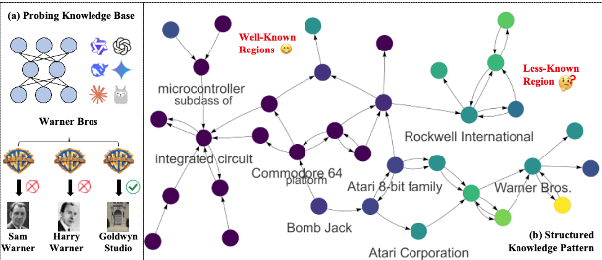

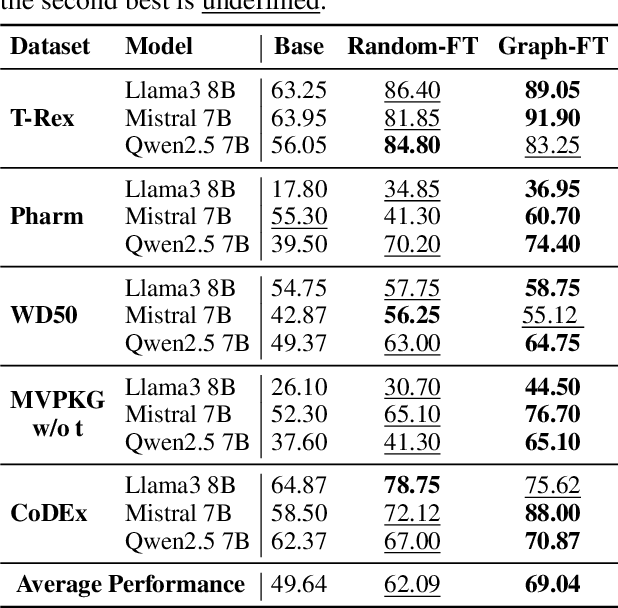
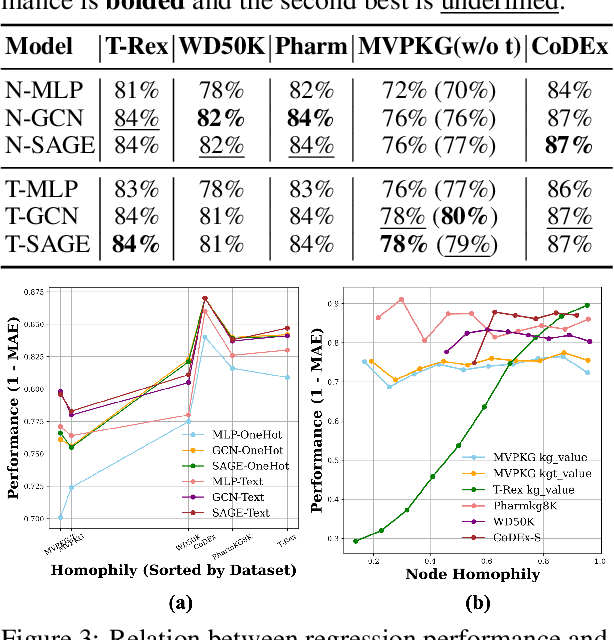
Abstract:Large language models have been extensively studied as neural knowledge bases for their knowledge access, editability, reasoning, and explainability. However, few works focus on the structural patterns of their knowledge. Motivated by this gap, we investigate these structural patterns from a graph perspective. We quantify the knowledge of LLMs at both the triplet and entity levels, and analyze how it relates to graph structural properties such as node degree. Furthermore, we uncover the knowledge homophily, where topologically close entities exhibit similar levels of knowledgeability, which further motivates us to develop graph machine learning models to estimate entity knowledge based on its local neighbors. This model further enables valuable knowledge checking by selecting triplets less known to LLMs. Empirical results show that using selected triplets for fine-tuning leads to superior performance.
ChartLens: Fine-grained Visual Attribution in Charts
May 25, 2025



Abstract:The growing capabilities of multimodal large language models (MLLMs) have advanced tasks like chart understanding. However, these models often suffer from hallucinations, where generated text sequences conflict with the provided visual data. To address this, we introduce Post-Hoc Visual Attribution for Charts, which identifies fine-grained chart elements that validate a given chart-associated response. We propose ChartLens, a novel chart attribution algorithm that uses segmentation-based techniques to identify chart objects and employs set-of-marks prompting with MLLMs for fine-grained visual attribution. Additionally, we present ChartVA-Eval, a benchmark with synthetic and real-world charts from diverse domains like finance, policy, and economics, featuring fine-grained attribution annotations. Our evaluations show that ChartLens improves fine-grained attributions by 26-66%.
A Personalized Conversational Benchmark: Towards Simulating Personalized Conversations
May 20, 2025Abstract:We present PersonaConvBench, a large-scale benchmark for evaluating personalized reasoning and generation in multi-turn conversations with large language models (LLMs). Unlike existing work that focuses on either personalization or conversational structure in isolation, PersonaConvBench integrates both, offering three core tasks: sentence classification, impact regression, and user-centric text generation across ten diverse Reddit-based domains. This design enables systematic analysis of how personalized conversational context shapes LLM outputs in realistic multi-user scenarios. We benchmark several commercial and open-source LLMs under a unified prompting setup and observe that incorporating personalized history yields substantial performance improvements, including a 198 percent relative gain over the best non-conversational baseline in sentiment classification. By releasing PersonaConvBench with evaluations and code, we aim to support research on LLMs that adapt to individual styles, track long-term context, and produce contextually rich, engaging responses.
Disambiguation in Conversational Question Answering in the Era of LLM: A Survey
May 18, 2025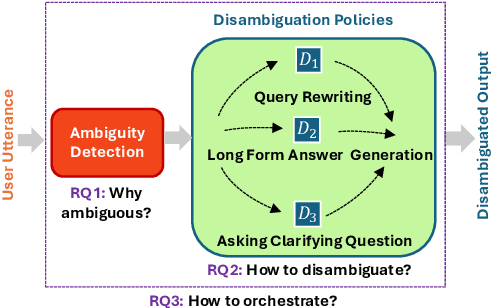
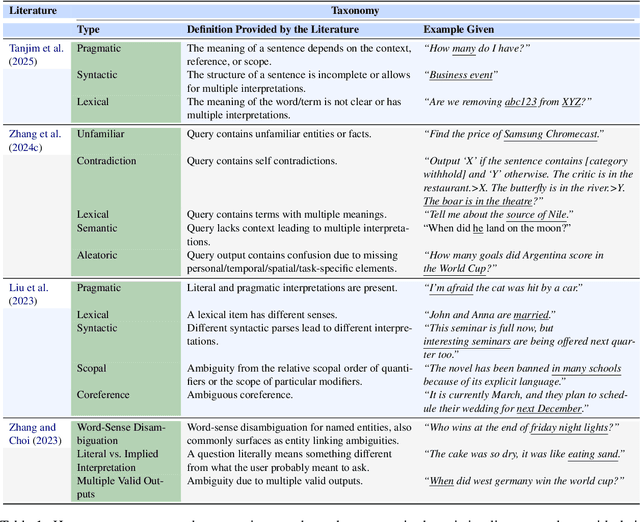
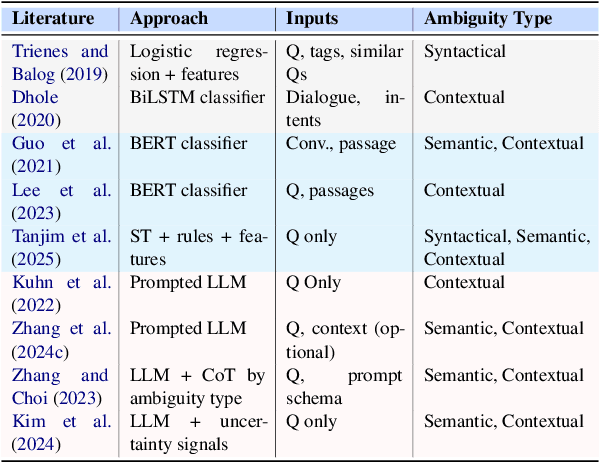
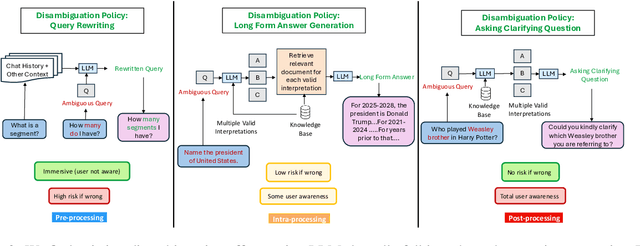
Abstract:Ambiguity remains a fundamental challenge in Natural Language Processing (NLP) due to the inherent complexity and flexibility of human language. With the advent of Large Language Models (LLMs), addressing ambiguity has become even more critical due to their expanded capabilities and applications. In the context of Conversational Question Answering (CQA), this paper explores the definition, forms, and implications of ambiguity for language driven systems, particularly in the context of LLMs. We define key terms and concepts, categorize various disambiguation approaches enabled by LLMs, and provide a comparative analysis of their advantages and disadvantages. We also explore publicly available datasets for benchmarking ambiguity detection and resolution techniques and highlight their relevance for ongoing research. Finally, we identify open problems and future research directions, proposing areas for further investigation. By offering a comprehensive review of current research on ambiguities and disambiguation with LLMs, we aim to contribute to the development of more robust and reliable language systems.
Generative AI for Autonomous Driving: Frontiers and Opportunities
May 13, 2025Abstract:Generative Artificial Intelligence (GenAI) constitutes a transformative technological wave that reconfigures industries through its unparalleled capabilities for content creation, reasoning, planning, and multimodal understanding. This revolutionary force offers the most promising path yet toward solving one of engineering's grandest challenges: achieving reliable, fully autonomous driving, particularly the pursuit of Level 5 autonomy. This survey delivers a comprehensive and critical synthesis of the emerging role of GenAI across the autonomous driving stack. We begin by distilling the principles and trade-offs of modern generative modeling, encompassing VAEs, GANs, Diffusion Models, and Large Language Models (LLMs). We then map their frontier applications in image, LiDAR, trajectory, occupancy, video generation as well as LLM-guided reasoning and decision making. We categorize practical applications, such as synthetic data workflows, end-to-end driving strategies, high-fidelity digital twin systems, smart transportation networks, and cross-domain transfer to embodied AI. We identify key obstacles and possibilities such as comprehensive generalization across rare cases, evaluation and safety checks, budget-limited implementation, regulatory compliance, ethical concerns, and environmental effects, while proposing research plans across theoretical assurances, trust metrics, transport integration, and socio-technical influence. By unifying these threads, the survey provides a forward-looking reference for researchers, engineers, and policymakers navigating the convergence of generative AI and advanced autonomous mobility. An actively maintained repository of cited works is available at https://github.com/taco-group/GenAI4AD.
 Add to Chrome
Add to Chrome Add to Firefox
Add to Firefox Add to Edge
Add to Edge